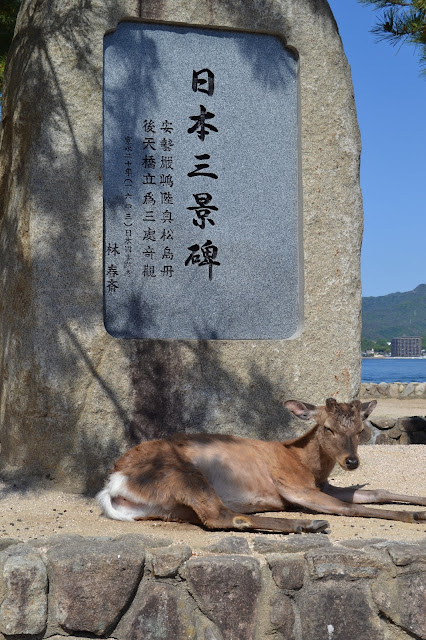The next day we made the trek to Miyajima, a little island off the coast of Hiroshima. For those as geographically disinclined as myself, I've attached a little map to orient yourself:
What's so famous about Miyajima that I forced my parents to take a ferry over there and spend half a day? If you've been studying your Japanese, then you would know that Miyajima is Japanese for "Shrine Island". So what, you ask me with a yawn. Why, it's only the Itsukushima Shrine, designated by Confucian scholar Shunsai Hayashi as one of "Three Most Scenic Spots of Japan" AND later designated a World Cultural Heritage site!
This is the plaque designating Miyajima as one of the most scenic spots in Japan.
To get to Miyajima from Hiroshima, you're required to take a short (10 minute) ferry ride from Miyajima-guchi station or Hiroden-miyajima-guchi station. Once you're on the island, you're greeted by lots of aggressive deer who like to eat your maps, poop, or wait to shop at stores (all of which happened to me):
A short walk later, we came upon the O-torii Gate of Itsukushima Shrine... the reason this isn't your average torii gate is because it was designed so that during high tide it would look as though it's floating. The reason? Miyajima (the island) was considered a sacred island that commoners were not allowed to walk on... so, to circumvent and allow pilgrims to enter the shrine, they built it as a sort of pier somewhat disconnected from the island. Pilgrims were required to enter past the torii gate via boats.
The gate stays in place because the top rail of the torii is hollow and contains 7 tons of fist-sized stones. This current incarnation is the eighth, erected in 1875.
Once past the torii gate we were greeted by the actual Itsukushima Shrine, which is dedicated to the three goddess of sea, traffic safety, fortune and accomplishment (Ichikishima-hime, Tagitsu-hime, and Tagori-hime). The shrine itself was built in 593 and then later remodeled in 1168, and its vermilion color is used to keep evil spirits away.
After that, we saw the five storied pagoda that was next to the Toyokuni Shrine (also known as Senjokaku, or the Hall of One Thousand Tatami Mats).
Last but not least, we saw Miyajima O-shakushi... or the World's Largest Wooden Rice Scoop! Miyajima is known as the birth place of the rice scoop. Legend has it that a Buddhist monk named Seishin had a dream where Benzaiten (Goddess of Good Fortune) came to him with a Japanese lute in her hands, the shape of which he traced into a rice scoop. After teaching its design to the locals, it spread like wildfire throughout Japan.
Our time in Hiroshima and Miyajima completed, our next stop was Kyoto's Bamboo Forest and Golden Temple. Don't worry, their magnificence will continue to be undermined by my camera/photographic skill in a later blog post to appear sometime this week!
.JPG)
.JPG)

.JPG)
.JPG)










































